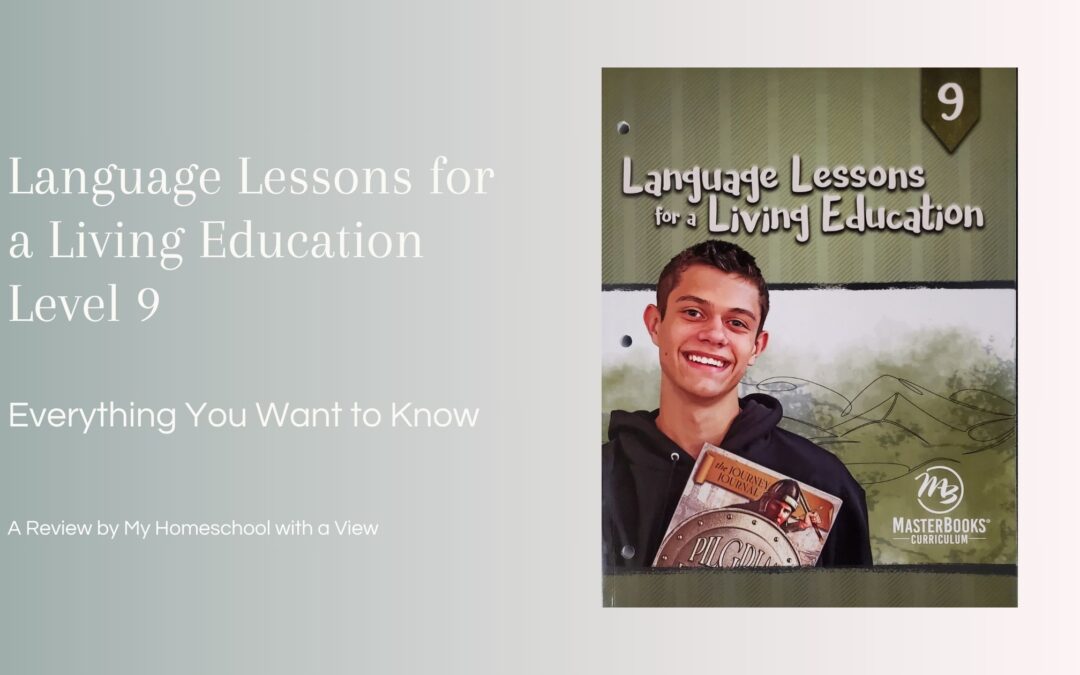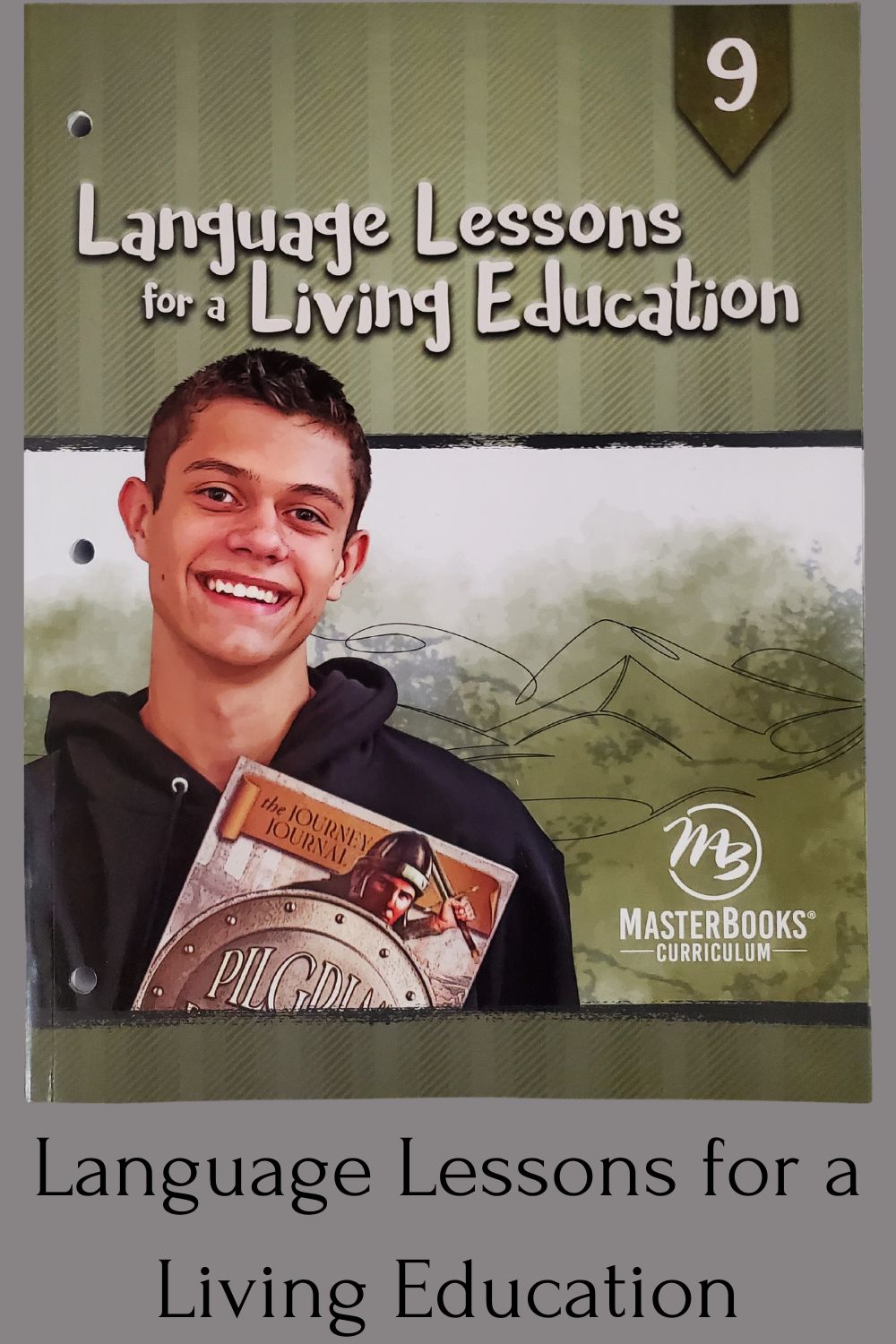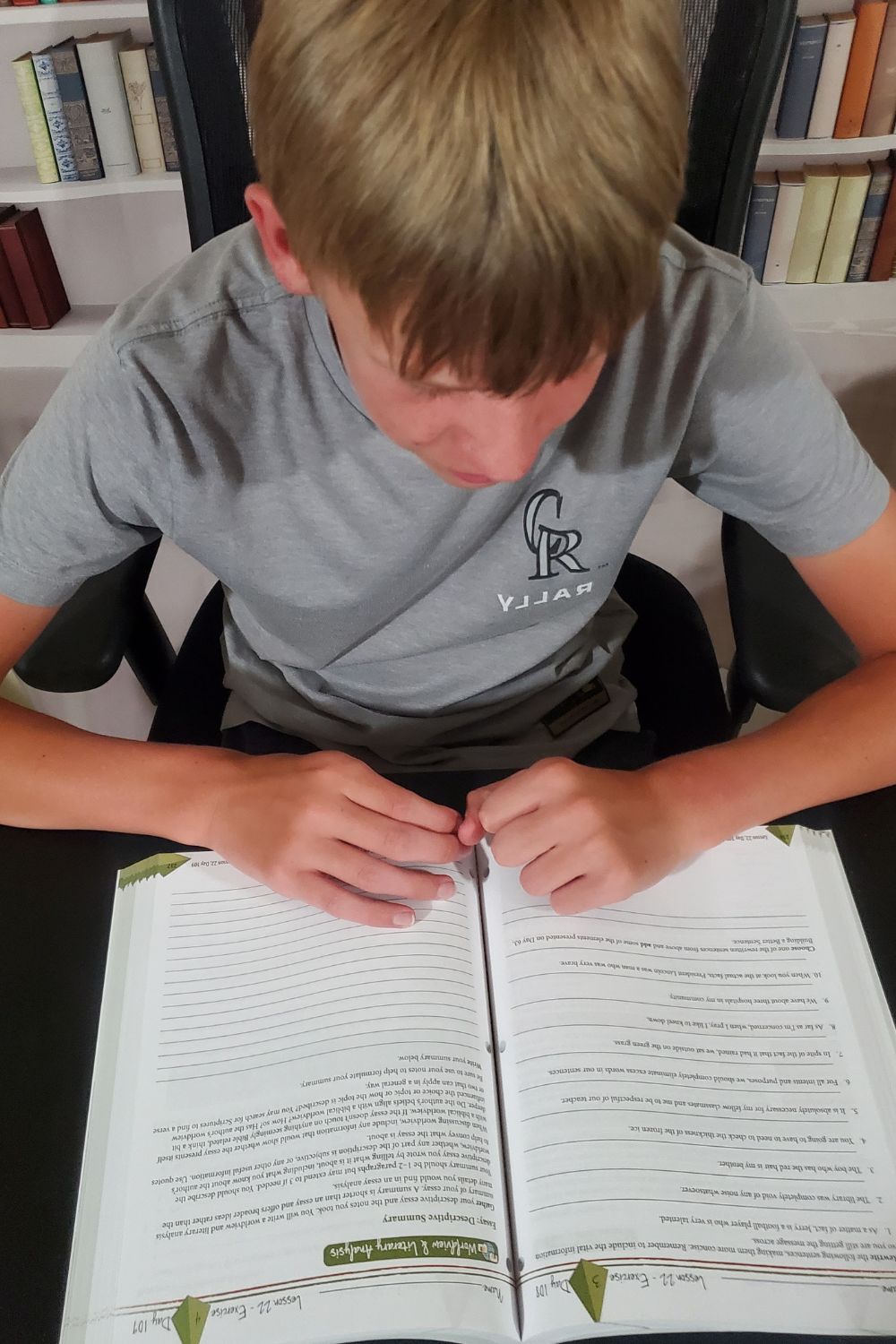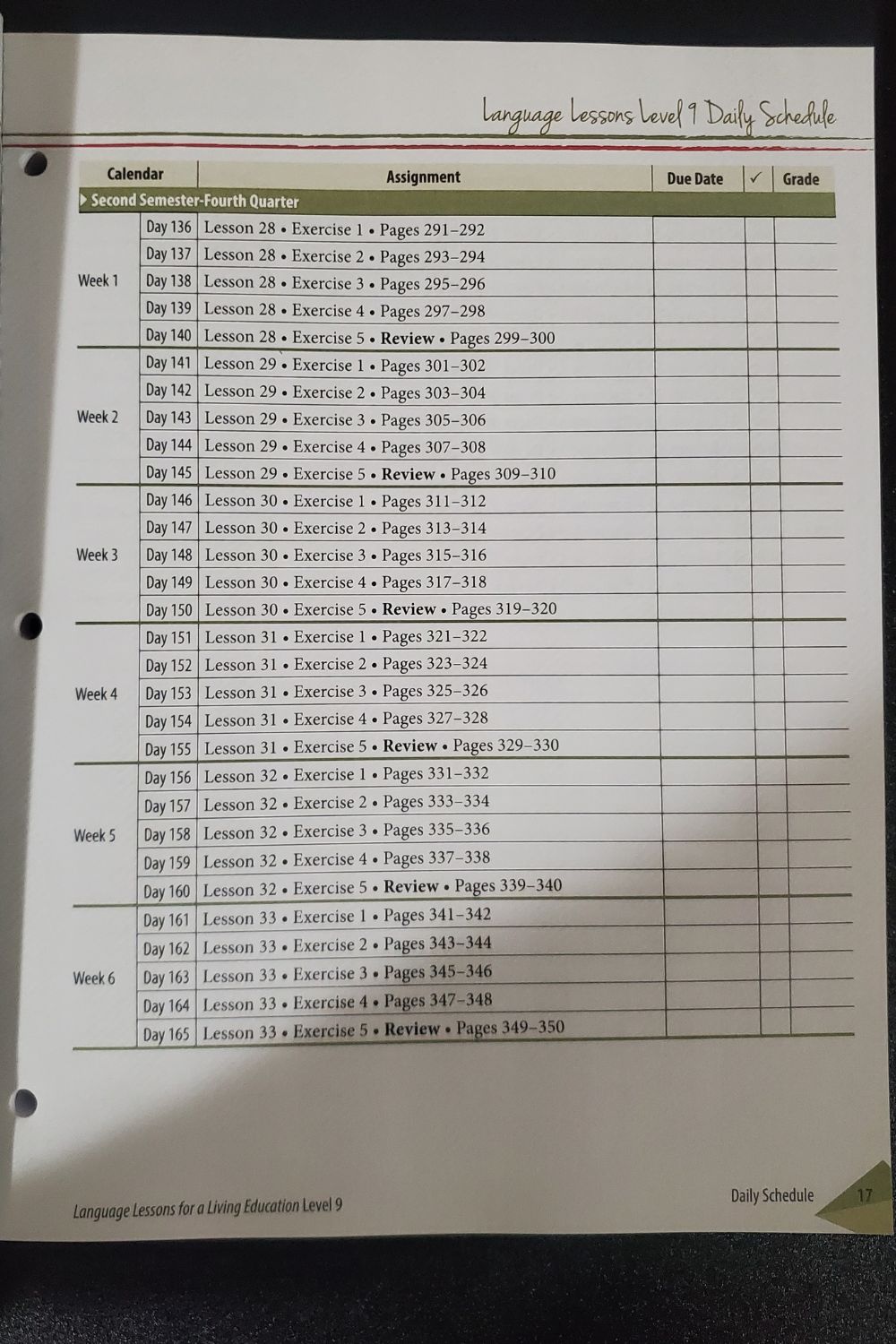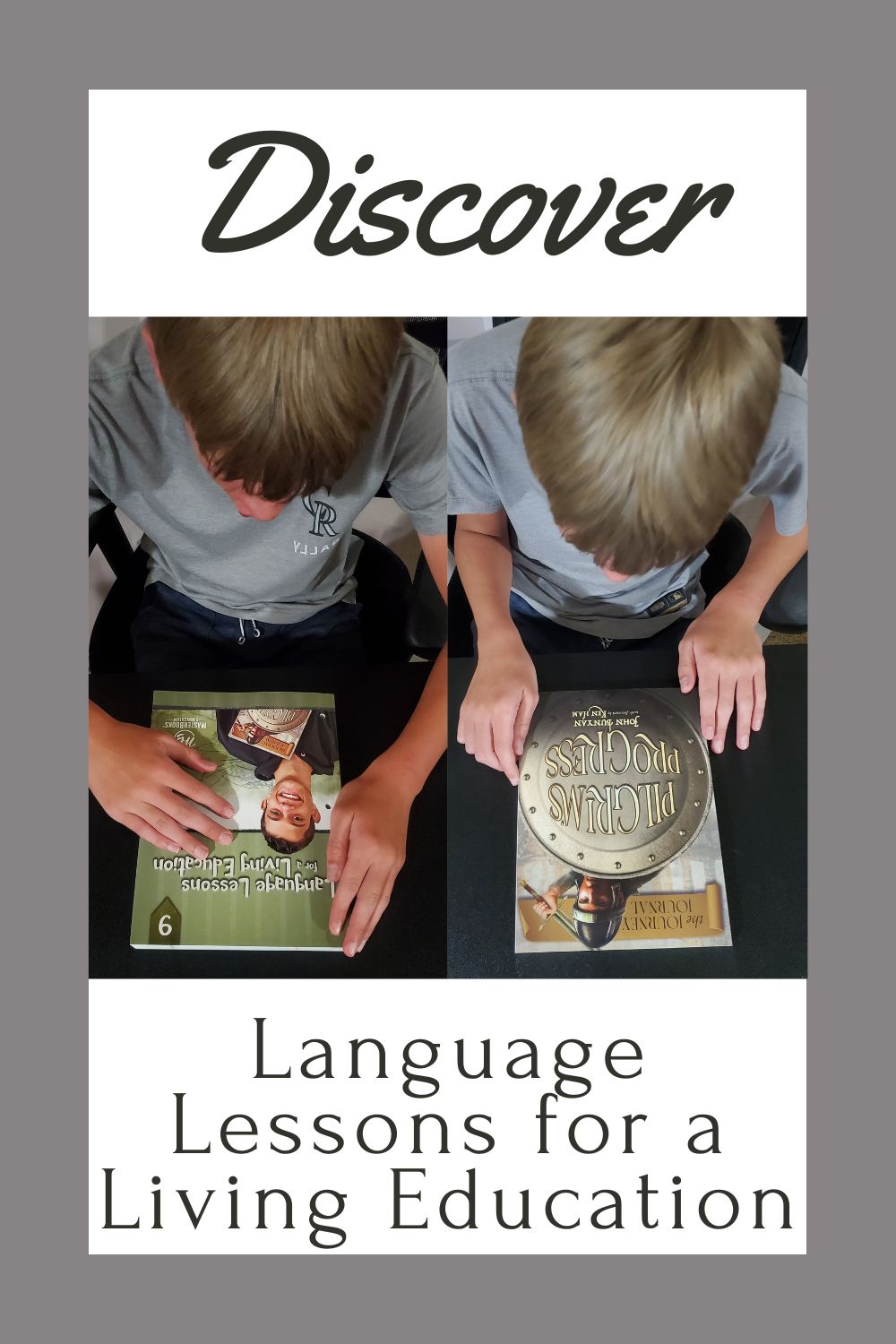This post is a comprehensive review of Language Lessons for a Living Education.
This is a sponsored post and My Homeschool with a View, LLC was compensated to review and write about Language Lessons for a Living Education from Master Books. For more information on sponsored posts, read our Affiliate and Advertising Disclosure. Thank you to Master Books for sponsoring this post and providing Language Lessons for a Living Education Level 9 Set for this post!
If you take a second and really listen, you can hear the sound of Master Books fans everywhere cheering. Indeed, they are cheering on the release of the new Language Lessons for a Living Education Level 9.
My youngest used levels 2-6 of Language Lessons for a Living Education, but at the time Master Books didn’t seem to have plans to extend the series to high school. Now my son and many others like him are cheering on this change of plans, as Language Lessons for a Living Education now has middle and high school levels, with more in the works.
Therefore, I’m super excited to connect you with this newer resource. Language Lessons for a Living Education Level 9 is a unique approach to ninth grade homeschool language arts curriculum.
In this review we will dive into the approach of Language Lessons for a Living Education Level 9, the features of this Master Books Curriculum, and how to utilize it to its full potential.
This post is all about Language Lessons for a Living Education.
Language Lessons for a Living Education Overview
All in One Homeschool Language Arts
First of all, Language Lessons for a Living Education is a complete homeschool language arts course. As of the time I am writing this, Levels 1-10 are available.
Each level includes a full one year course of study for language arts. This means instruction in grammar, writing, spelling, vocabulary, reading and handwriting are included throughout the course.
As mentioned earlier, I have used several levels of Language Lessons for a Living Education at My Homeschool with a View. Each level follows a familiar format over a five-day schedule.
Specifically, we like the predictability of the lessons. Knowing what is coming up each day helps us look forward to preferred activities, and makes the less preferred activities less of a drudgery. Changing up the tasks while always progressing the lessons and then adding in review is kind of the magic homeschool formula.
Most LLFLE courses require the use of a companion reader, which varies depending on which level you are using. Our favorite reader of the earlier levels was 101 Favorite Stories from the Bible. This beautifully illustrated Bible storybook keeps readings short and sweet, yet true to the Biblical narrative. In fact, it can stand alone in your homeschool no matter what you use for language arts curriculum.
Ninth Grade Homeschool Curriculum
Level 9 of LLFLE takes the format of the earlier levels of the curriculum, and grows it up. Everything from the artwork to the lesson format is familiar, yet reflects the growing maturity of our older kids.
Notably, culturally relevant lessons, such as texting etiquette are coverd in this level. This lesson includes all of the proper texting procedures, from ghosting to using appropriate emojis.
Ninth Grade Homeschool Literature
Additionally, Level 9 utilizes Pilgrim’s Progress: The Journey Journal. This companion book is an integral part of this language arts curriculum, with assigned readings and questions incorporated into the weekly lessons.
I was pleasantly surprised by Pilgrim’s Progress: The Journey Journal. Pilgrim’s Progress has never been my favorite piece of literature. I know, I know. Some may not classify me as a real homeschooler if I take that view point.
However, the Journey Journal is different in the fact that it gives scripture references and a place for note taking. Everything from the font size to the feel of the book makes it seem more modern while staying true to the story. If you hold this book in your hands and get a feel for it, you will see that it is much more appealing than most versions of this literary work.
The best part of Pilgrim’s Progress: The Journey Journal is that it gives the definitions of uncommon vocabulary words at the beginning of each chapter. We don’t have to stop reading to go look up unfamiliar words.
While there is a place for learning how to find answers, there’s also a time for handing over the information. I appreciate that Master Books recognizes this necessity. It makes the reading feel like less of a chore, especially for someone like me who isn’t a super fan of the story.
Traditional or Charlotte Mason Homeschool Language Arts?
Personally, I have always enjoyed the Master Books eclectic approach to homeschool curriculum. Actually, I was calling their approach eclectic while they were still identifying as Charlotte Mason inspired.
While you can definitely see some Charlotte Mason influence with the inclusion of picture study, oral and written narration, hymn study, poetry and recitation, Language Lessons for a Living Education Level 9 fits more into the traditional homeschool style.
For starters, it is a traditional workbook format. This is actually one of the things that I really like about it as my youngest has always done best with workbooks.
Next, it doesn’t rely only on narration for writing instruction. Level 9 gives direct instruction for essay format writing. I appreciate this direct instruction, because as a professional writer, I am terrible at teaching writing. I need a curriculum that walks my kids through the process of writing and Language Lessons for a Living Education Level 9 fits the bill.
That being said, it is not fully traditional either. While it comes across as traditional in form and format, you don’t get the drill and kill that seems to be a hallmark of traditional homeschool curriculum. I think it definitely leans more traditional especially at Level 9, but not quite all the way traditional. This is why it works well for my family. We don’t fully fit into one method of homeschooling either.
Masterbooks Language Lessons for a Living Education Key Features
Included Homeschool Schedule
As with all Master Books curriculum, LLFLE Level 9 is open and go. This includes a five day, already done for you schedule in the beginning of the book.
This schedule covers 180 days of homeschool language arts lessons, which should meet most state requirements (always check state laws for yourself). Each lesson spans five days, and rotates concepts each day of the week. Every fifth day is a review day.
If you prefer a four day homeschool schedule like we do, I have a couple of suggestions to make the curriculum fit into a four day schedule. The first option is to skip the review day. If your kids can handle learning without review, this is what I would do. The other option is to take advantage of the short lessons (only 2-3 pages per lesson) and incorporate some of the fifth day review activities throughout the week.
Integrated Homeschool Language Arts
Moreover, Language Lessons for a Living Education integrates all language arts components. Meaning, you don’t need separate writing, grammar, spelling, vocabulary, and literature curriculum. Level nine is two books and it covers your entire ninth grade language arts curriculum.
As I noted earlier, this is a truly open and go curriculum. We are a family that likes to travel, and at times we take our homeschool with us, depending on the trip. Integrated curriculum is not only a time saver, it is also a space saver. For me, it’s all about practicality and Masterbooks homeschool curriculum is extremely practical.
Progressive Skill Building
Furthermore, the five day lesson format ensures that skills are built in a progressive manner. For example, exercise 2 of each weekly lesson addresses grammar and punctuation. Each week, you spend one day focusing on new grammar and punctuation concepts, and then build on that the following week. This keeps skills moving forward in a logical progression, without drudgery of drilling a concept over and over again.
I like this format because it covers all concepts, but keeps learning interesting by changing the focus of each day. Instead of spending a week or a month expecting kids to learn all of the grammar concepts they need for the year, it is broken up into one day a week for the entire year.
Bible Based Homeschool Curriculum
Master Books puts forth a definite Biblical worldview, which is seen in all subjects of all of their curriculum. The Bible is fully integrated into every lesson of Language Lessons for a Living Education.
I really like this full integration as I don’t feel like we need to use a separate Bible curriculum. The Bible is a foundational part of this course.
However, if you are a non-religious homeschooler, you won’t be able to skip the Biblical parts of this curriculum. It is fully integrated into the lessons and not just a piece of scripture thrown in here and there. I would still encourage you to take a look at the curriculum, simply because it is unique and I don’t think you will find a non-religious duplicate or even something remotely simliar that is non-religious.
Language Lessons for a Living Education Review
Language Lessons for a Living Education Considerations
LLFLE is what I would call a lighter curriculum. It is not rigorous or advanced, but takes a gentle approach to traditional language arts instruction.
A common concern people have with this curriculum is if it is too light or not enough.
I think this is a difficulty that goes along with not fitting into one single homeschool style. It incorporates elements of Charlotte Mason, but it is definitely not Charlotte Mason. Likewise, it follows the format of traditional homeschooling, but not quite. With any curriculum that doesn’t fall into one style, it can miss the instructional depth that comes with following a single approach to homeschooling.
I don’t think this is a bad thing. Rigor doesn’t equal better. I think searching for advanced or rigorous homeschool curriculum is a weakness in the homeschool world. I believe it has more to do with people expecting us to prove we are doing a good job as homeschoolers than what is always best for our kids.
A friend recently reminded me of this. The goal is to learn, not to make learning difficult. Our kids can learn and thrive from a gentle language arts curriculum just as well as they can from a rigorous curriculum. And my son has definitely learned and thrived using this homeschool program.
My View of Language Lessons for a Living Education Level 9
Language Lessons for a Living Education Level 9 is an exciting addition to the series, expanding its offerings to older students. This curriculum builds on the solid foundation laid in the earlier levels, maintaining a familiar format while growing with the students. The inclusion of culturally relevant lessons and a unique approach to literature, as seen with Pilgrim’s Progress: The Journey Journal, only adds to its appeal.
Integrating all language arts components into a comprehensive, open-and-go curriculum makes it a practical choice for homeschool families. The progressive skill-building approach ensures steady progress without overwhelming our kids. A strong Biblical worldview throughout the lessons provides a rich homeschool experience for families seeking biblically based homeschool curriculum.
While Master Books curriculum may not fit neatly into one homeschool style, its eclectic approach is perfect for our family. Its gentle method makes the curriculum approachable and invites enthusiasm going into a new homeschool year. It offers a balanced, engaging, and thorough language arts education that supports our kids’ growth and development. For families seeking a well-rounded, Biblically based curriculum, Language Lessons for a Living Education Level 9 is a great choice.
This post is all about Language Lessons for a Living Education.
Other posts you may like:
Discover Biblical Greek for your Homeschool Bible Curriculum (myhomeschoolwithaview.com)
The Essential Guide to Eclectic Homeschooling (myhomeschoolwithaview.com)
Elementary U.S. Geography and Social Studies – Master Books (myhomeschoolwithaview.com)

